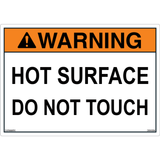How to Properly Read Chemical Labels
No matter what chemicals you use, it’s vital to fully understand their safety labels. In fact, failing to understand these hazard labels could put you in a life-threatening situation. However, being able to comprehend these warning labels or safety decals isn’t an easy feat. With so many shapes, colors, and logos to understand, it can all be very confusing. Luckily, we’re here to help. In this post, we’ll discuss some tips on how to properly read these hazard labels.
What these labels look like
While there are a variety of chemical labels out there, we’ll examine the most common type of them all: the US National Fire Protection Association (NFPA) chemical label. Although it’s pretty simplistic, these chemical safety labels provide tons of useful information if you’re able to understand them. To simplify the process, NFPA developed color-coded labels. Each color on the label represents a certain type of hazard.
What these colors mean
The first step to understanding these labels involves understanding what these colors represent. However, understanding these colors means you also have to understand the NFPA numbering system. All NFPA chemical warning decals will have a diamond shape with four squares inside of it. Each square will have one of four colors: red, blue, yellow, or white. Additionally, each colored square will have a number between 1 through 4. Now let’s take a look at what these numbers and colors really mean:
Blue: Health Risks
The blue square on these hazard decals refers to health risks. Each number in these blue squares has a different meaning. Here are the numbers with their corresponding meanings:
- 4 - If not handled safely, this substance is a severe health risk. If a four is present in this blue section, the substance could cause death or an irreversible injury.
- 3 - The substance could cause a temporary or irreversible injury.
- 2 - Being exposed to this substance could lead to temporary incapacitation.
- 1 - Irritation could occur.
- 0 - There aren’t any health hazards.
Red: Fire Risks
- 4 - This contains a flammable vapor or gas that burns readily.
- 3 - A flammable liquid or solid that can be readily ignited.
- 2 - In order to ignite, the substance needs to be ignited
- 1 - Preheating must occur before ignition.
- 0 - There aren’t any fire hazards.
Yellow: Reactivity Hazards
- 4 - The substance is readily capable of an explosion or detonation.
- 3 - If exposed to heat or an ignition source, the substance could detonate.
- 2 - The substance is readily capable of a non-explosive reaction.
- 1 - At high temperatures, the substance may become unstable.
- 0 - The substance is stable.
White: Special Hazards
Rather than numbers, the white squares rather have an acronym or symbol that represents a certain hazard. Check out the meanings of them below:
- OX - Oxidizer
- ACID - Acid
- ALK - Alkali
- COR - Corrosive
- Symbol that looks like a ‘W’ with a line through it - Use no water
- Symbol that looks like a ceiling fan - Radioactive
Whether at home or work, understanding how to read these chemical hazard labels can be the difference between life or death.
Recent Posts
-
The Power of Product-Specific Kitting for Labels
In today's competitive business landscape, efficient and impactful product labeling plays a vital ro …May 16, 2023 -
Which Label is Best for Heat Resistance
When it comes to labeling products, it's important to consider factors such as durability and heat r …May 12, 2023 -
Buying Custom Safety Labels
Safety labels play a crucial role in ensuring that people remain safe in a variety of environments. …May 11, 2023




